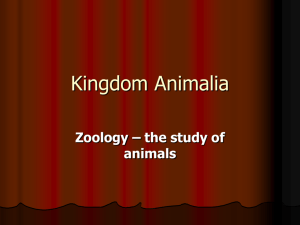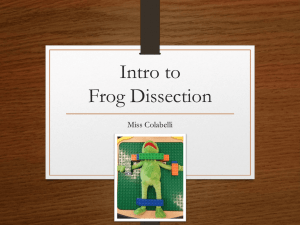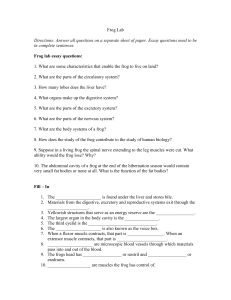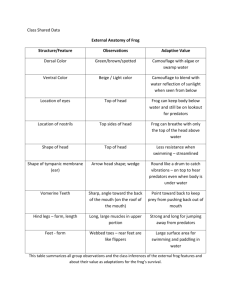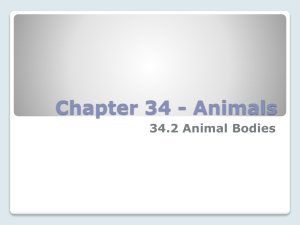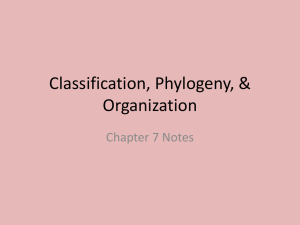Kingdom Animalia (Animals)
advertisement
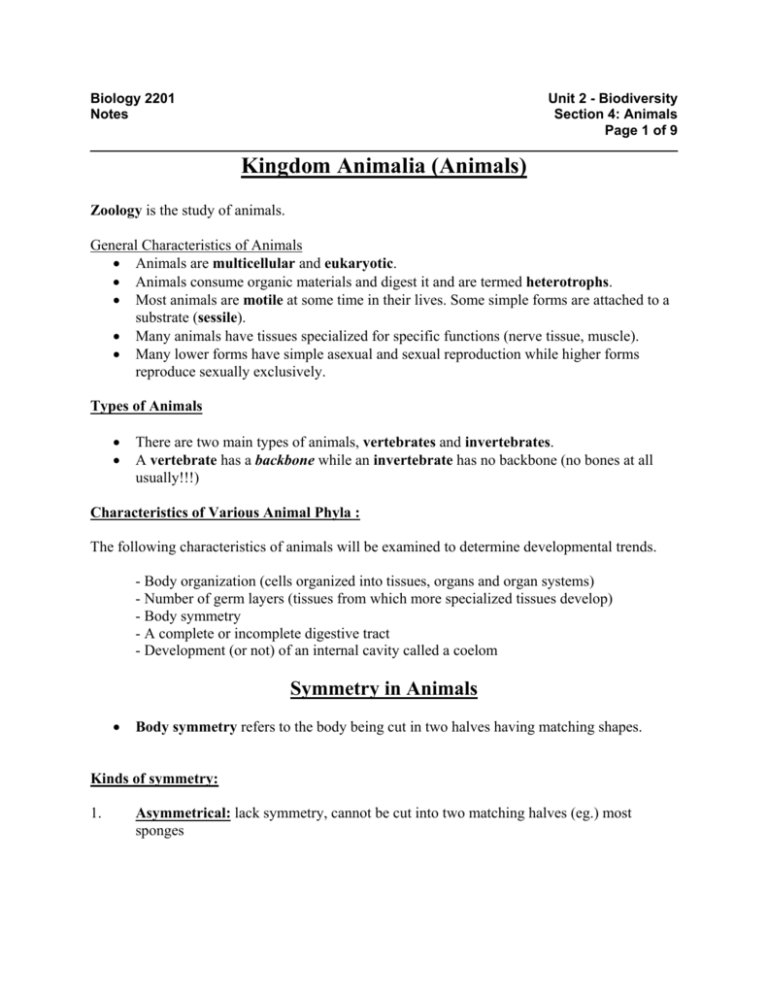
Biology 2201 Notes Unit 2 - Biodiversity Section 4: Animals Page 1 of 9 Kingdom Animalia (Animals) Zoology is the study of animals. General Characteristics of Animals • Animals are multicellular and eukaryotic. • Animals consume organic materials and digest it and are termed heterotrophs. • Most animals are motile at some time in their lives. Some simple forms are attached to a substrate (sessile). • Many animals have tissues specialized for specific functions (nerve tissue, muscle). • Many lower forms have simple asexual and sexual reproduction while higher forms reproduce sexually exclusively. Types of Animals • • There are two main types of animals, vertebrates and invertebrates. A vertebrate has a backbone while an invertebrate has no backbone (no bones at all usually!!!) Characteristics of Various Animal Phyla : The following characteristics of animals will be examined to determine developmental trends. - Body organization (cells organized into tissues, organs and organ systems) - Number of germ layers (tissues from which more specialized tissues develop) - Body symmetry - A complete or incomplete digestive tract - Development (or not) of an internal cavity called a coelom Symmetry in Animals • Body symmetry refers to the body being cut in two halves having matching shapes. Kinds of symmetry: 1. Asymmetrical: lack symmetry, cannot be cut into two matching halves (eg.) most sponges Biology 2201 Notes Unit 2 - Biodiversity Section 4: Animals Page 2 of 9 2. Radial symmetry: division into equal halves by passing a plane through the central axis of the animal in any direction (eg.) starfish, jellyfish 3. Bilateral symmetry: division into equal halves only along a single plane. Each half is a mirror image of the other (eg.) most animals, humans (not perfect) Spatial relationships (bilateral symmetry) : Dorsal - upper side or back Ventral - lower side or belly Anterior - front region or head Posterior - hind, rear, or tail end Lateral - side Note: Animals with bilateral symmetry have a true head. It shows cephalization which refers to a concentration of nerve tissue and receptors at the anterior end of the animal’s body. Biology 2201 Notes Unit 2 - Biodiversity Section 4: Animals Page 3 of 9 Body cavity Coelom: A fluid filled cavity surrounded by the mesoderm — a layer of epithelial cells that line the body cavity and gut; (found in all vertebrates and many invertebrates). A coelom contains a peritoneum which is a covering membrane that lines the body cavity and covers the internal organs. Less complex vertebrates have a pseudocoelom. Pseudocoelom: A fluid filled cavity of variable shape which has no peritoneum. Importance of a body cavity: 1. 2. 3. Provides space where internal organs can be suspended without being affected by muscle pressure and body movement Provide space for internal organs to develop and expand Contain fluids which may assist in internal transport of nutrients, and gas exchange; Animals with a fluid-filled body cavity or coelom are called coelomates. Animals with a fluid-filled cavity and no peritoneum are pseudocoelomates. Animals without a coelom are called acoelomates. The development of a body cavity demonstrates complexity and evolutionary development in animals. The simplest animals have a single opening that acts as a mouth and anus. Complex animals have a gut with two openings, a mouth and anus. Biology 2201 Notes Unit 2 - Biodiversity Section 4: Animals Page 4 of 9 Number of Germ Layers Animal development depends on cell layers or germ layers. Layers: 1. 2. 3. Endoderm is inner layer of cells. It gives rise to digestive tract Ectoderm is the outer layer of cells. It gives rise to the skin and to the nervous system. Mesoderm is the middle layer of cells. It gives rise to the circulatory, skeletal and reproductive systems. r See the completed table below for a summary of invertebrate characteristics: Table # 3: Invertebrates. Developmental trends — Invertebrates 1. 2. 3. 4. 5. 6. 7. We go from simple to complex as organisms evolve. Simplest organisms have asymmetry. As complexity increases, we go to radial and finally bilateral symmetry. Organisms go from having no cavity to a false cavity to a true body cavity. Simpler organisms may reproduce sexually and asexually. As complexity increases, organisms reproduce only sexually. Simpler ones have two tissue layers, more complex have three tissue layers. Sessile to motile. Simpler ones have no tissue, no systems. As complexity increases, the more systems an organism has (both in # and complexity). Note: Many invertebrates are hermaphrodites (contain male and female parts), but rarely can they self-fertilize. Biology 2201 Notes Unit 2 - Biodiversity Section 4: Animals Page 5 of 9 r See the completed table below for a summary of vertebrate characteristics: Table # 4: Vertebrates. Common characteristics for all vertebrates would be: i) Presence of a notochord (backbone) ii) A dorsal nerve cord iii) Gill slits General Characteristics: 1. Endoskeleton, appendages, and skin 2. Closed circulatory system with an increasingly complex heart structure 3. Increased cephalization and increased size and complexity of the cerebrum 4. Presence of a coelom to hold increasingly complex systems for digestion, excretion, reproduction, circulation and respiration Evolutionary developmental Trends – Vertebrates 1. 2. 3. 4. 5. Adaptations leading from total dependence on water to survival on land (evolutionary trend from external fertilization towards internal fertilization). Development of a more complex heart structure (from a two chambered to three chambered to four chambered heart). Increase in cephalization (concentration of nerve tissue in anterior region). Increase in size and complexity of the cerebrum (anterior part of brain). Body system functions increase in complexity with evolution. Why arthropods are the most successful class of animals? The main characteristics of an arthropod are: • Exoskeleton, jointed appendages, segmented bodies, and an open circulatory system. • They are found in a wide range of habitats. It seems that they have evolved from a segmented ancestor. • They undergo sexual reproduction with internal fertilization and separate sexes: (although some may be hermaphroditic). Diversity (Phylum Arthropoda) is due to their: 1. Rigid, jointed external skeleton or exoskeleton (for protection). 2. Well-defined head with jointed appendages 3. Specialized body segments fused into distinct regions such as head, thorax and abdomen. 4. Well-developed nervous system. 5. Different structures and functions for obtaining nourishment Biology 2201 Notes Unit 2 - Biodiversity Section 4: Animals Page 6 of 9 Example of the Frog Life Cycle (as an example of an animal): (See Figure 6.26, p. 193). A frog is an example of an amphibian. A frog will undergo external fertilization; (the sperm and egg meet outside the bodies of both parents).The male frog produces the sperm and the female frog produces the eggs. Fertilization of frog eggs is external. During mating, the male frog mounts a female frog and helps to squeeze the eggs from the female’s body. The male will then release sperm on top of the eggs. Once an egg has been fertilized, development begins immediately. The larva of the frog or tadpole will emerge from the egg in a few days. The young tadpole has a tail for swimming and gills for respiration. This tadpole stage of a frog may last a few months up to two years, depending on the frog species. Tadpoles eat plants and algae. The tadpole will undergo a complete change in form or metamorphosis; (older tadpoles start to develop legs). This metamorphosis usually takes one or two months and the young frog will have well-developed legs, but no tail. It eventually becomes an adult frog fully adapted for life on the land. Biology 2201 Notes Unit 2 - Biodiversity Section 4: Animals Page 7 of 9 Biology 2201 Notes Unit 2 - Biodiversity Section 4: Animals Page 8 of 9 Biology 2201 Notes Unit 2 - Biodiversity Section 4: Animals Page 9 of 9
